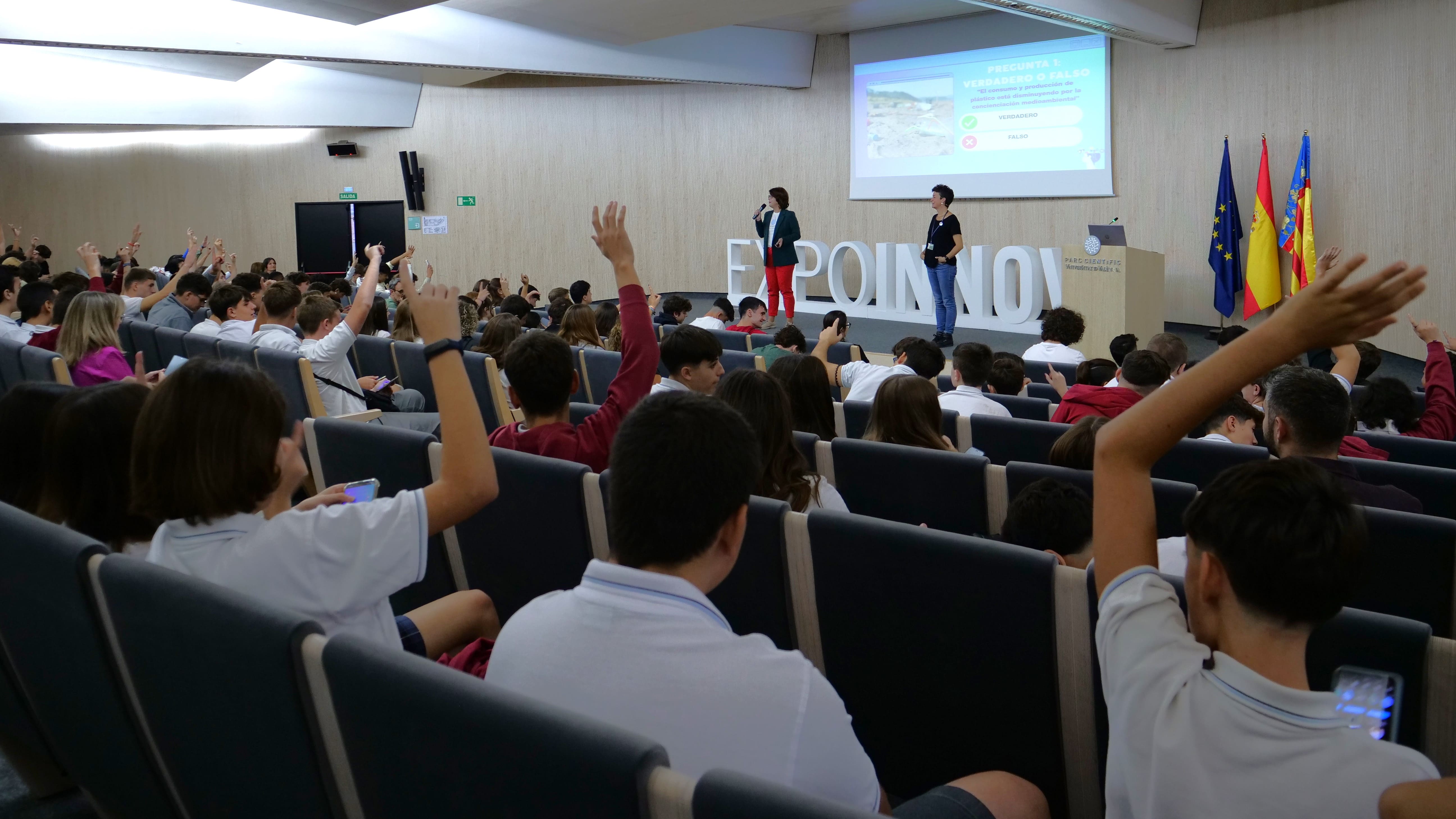Expoinnova, a science and innovation outreach event organized by the University of Valencia Science Park (PCUV) with the support of the Regional Ministry of Education, Universities and Employment, has reached its fifth edition. Since its inception, the PCUV event aims to awaken interest and vocations for scientific-technical careers among pre-university students. This year, the event will take place on October 16, 17 and 18, both in person and online at the Marie Curie Auditorium, with a program of six lectures by professionals working in PCUV research centers and companies
Science and innovation are the levers of the future. To arouse interest and vocations for scientific-technical careers among pre-university students, the University of Valencia Science Park Foundation (FPCUV), with the collaboration of the University of Valencia (UV) and the support of the Regional Ministry of Education, Universities and Employment, is organizing the fifth edition of the Expoinnova outreach event, a meeting place that began in 2020. In response to the success of previous editions, this year the event is extended to three days, October 16, 17 and 18, in online and face-to-face format, with a program of six presentations given by the staff of the research institutes and companies that make up the innovative ecosystem of the Science Park.
“The dissemination of research and innovative developments of technology-based companies is essential to stimulate the students of secondary and high school at a crucial time to project their careers. Expoinnova aims to contribute to the students of the Valencian Community to have the opportunity to know spaces where innovation and knowledge-based applications are promoted and developed and to awaken scientific-technical vocations at an early age,” said Pedro Carrasco, director of the PCUV.
The data from the four previous editions show the growing interest in the outreach activities carried out at the Scientific Park. “The 35 sessions of these four years have achieved a face-to-face attendance of 40 schools and nearly 1,400 students and a streaming follow up of about 900 schools and 35,000 students. The balance allows us to affirm that Expoinnova represents a key informative event in the PCUV environment for the Valencian educational system in the fields of science, technology and innovation,” says Encarna Torres, program coordinator at the FPCUV.
he 35 sessions of these four years have achieved a face-to-face attendance of 40 schools and nearly 1,400 students and a streaming follow up of about 900 schools and 35,000 students
-10.jpg?width=1200&length=1200&name=Adaptaciones%20Programa%20%2B%20CV%20Ponentes_revisado%20CASTE%20fotos_Linkedin%20(16-9)-10.jpg)
-11.jpg?width=1200&length=1200&name=Adaptaciones%20Programa%20%2B%20CV%20Ponentes_revisado%20CASTE%20fotos_Linkedin%20(16-9)-11.jpg)
-12-1.jpg?width=1200&length=1200&name=Adaptaciones%20Programa%20%2B%20CV%20Ponentes_revisado%20CASTE%20fotos_Linkedin%20(16-9)-12-1.jpg)

-14.jpg?width=1200&length=1200&name=Adaptaciones%20Programa%20%2B%20CV%20Ponentes_revisado%20CASTE%20fotos_Linkedin%20(16-9)-14.jpg)
-15.jpg?width=1200&length=1200&name=Adaptaciones%20Programa%20%2B%20CV%20Ponentes_revisado%20CASTE%20fotos_Linkedin%20(16-9)-15.jpg)
From chips and bacteria that store photos to light beams and black holes that explain the universe
The fifth edition of Expoinnova welcomes the participation of six speakers who will bring together in a fun and entertaining way disciplines as diverse as microelectronics, microbiology, physics, synthetic biology and materials science.
The first day will begin with an interesting combination of light and innovative materials. On Wednesday, October 16, José Luis Oltra, physicist and science communicator with the social profile of Cuarentaydos, will explain how a simple beam of light can provide so much information about the composition, mass, speed or temperature of the stars of the universe; and Ana Cros, professor in the Department of Applied Physics at the UV and researcher at the Institute of Materials Science (ICMUV), will explore the knowledge about materials and their contribution to the revolutions of the past, present and future.
Life forms such as fungi and yeasts and black holes will be the focus of the third and fourth sessions, respectively. On Thursday, October 17, Ana Pérez Adrián, research technician and manager of FunGIALab (Fungal Genomics and Industrial Applications Lab) at the Institute of Agrochemistry and Food Technology (IATA), will unravel the microbiology of fungi and yeasts to raise awareness of the importance of extracting in the wild and study these tiny and mysterious beings; and Iván Martí Vidal, head of Instrumentation of the Astronomical Observatory (OAUV) and full professor in the Department of Astronomy and Astrophysics of the UV, will travel to the center of the galaxies to explain what the “event horizon” is, a surface where time has stopped since shortly after the Big Bang, when black holes were formed, and will explain the “Event Horizon Telescope”, a device capable of turning the planet into a mega-telescope with a resolution that will make it possible to distinguish a golf ball from the Moon.
Engineering, in the form of microelectronics and synthetic biology, will also have its own space at Expoinnova on the third day. On Friday, October 18, Mónica Redón, director of medical product integration at the multinational Analog Devices, will present electronics as a branch of physics and engineering that studies the flow and control of electrons to show how the chips that make everyday devices like cell phones possible are designed and how various applications work to make photos come out sharper, how the cell phone recognizes the user to unlock itself or how a wristwatch is capable of measuring the pulse. Next, Alejandro Requena, biotechnologist and communicator linked to the Institute of Integrative Systems Biology (I2SysBio), will discover that bacteria that store photos or industrial factories inside yeast are not science fiction, but interesting examples that explain synthetic biology.
Enjoy all the editions of Expoinnova in our YouTube playlist
With the support of



